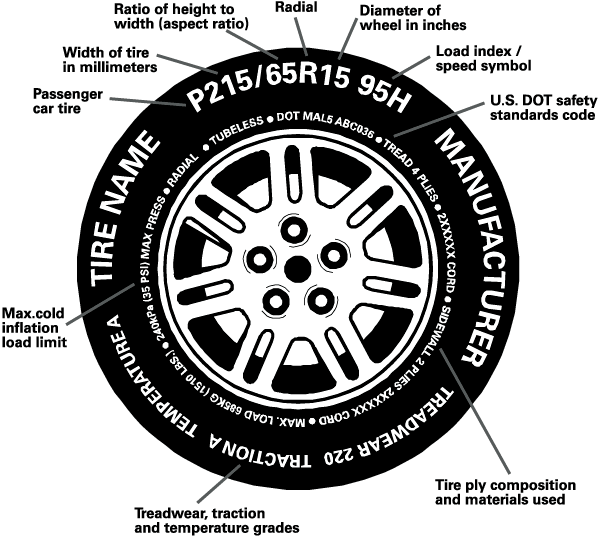In this section, we will introduce some of the signs registered on the tire to you, dear friends. These items include the following: 1- Tire production date 2- Tire size 3- Load index 4- Speed index 5- Mud and snow indicator (m+s) 6- TWI indicator 7- Permissible tread depth
o Tire production date:
The first two digits of this number represent the week of production and the next two digits represent the year of tire production.
Each year consists of 52 weeks. In example 3618, this tire was produced in the 36th week of 2018.
o Tire size:

Example: 185/65R14
185 tire cross-section width: the outer distance of both sides of the tire wall, including protrusions and tire markings (in millimeters)
65 aspect ratio of the tire: the result of dividing the cross-section height by the cross-section width (in percent)
The sign of radial tire is: R
14 is the inner diameter of the rim. (in inches)
Load index:
Marking of permissible load in two modes of single wheel and pair of wheels at different higher speeds
The maximum load bearing capacity of each tire can be seen on its wall
The amount of load on the tire should not exceed its maximum tolerance.
Bearing the maximum load on the tire is possible when the air pressure inside it is maximum.
The amount of load on the wheels must be controlled through the correct loading of the vehicle.
Speed index:
It does not mean to be allowed to move continuously at this speed, but it shows the durability of the tire at this speed in a limited time and the special conditions of testing on a special device. Despite this, a higher speed index means better technical capabilities of the tire.
o mud & snow (M+S):
Tires with a speed index lower than the index determined by the car manufacturer. As long as such tires are installed under the car, the speed of that car will be limited.
o TWI indicator:
It shows the tire surface wear limit for retreading.
Allowed tread depth:
In all EU member states, compliance with the minimum tread depth of 1.6 mm is mandatory for passenger, van and cargo tires. (At least in three quarters of the crispy periphery)
When this tread depth is low, the length of the brake line is increased in wet road conditions.
A thin layer of water between the tire and the road can lead to reduced contact with the road surface even at low speeds, which results in reduced steering control. This phenomenon is known as water scrolling.
These issues require changing the tires before their tread depth reaches the minimum allowed.

